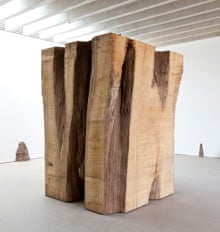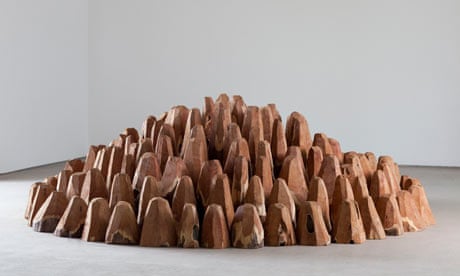It is pleasant to imagine that David Nash comes to us from the forest. He began, perhaps, as a sprout rising from the root of a fallen ash. The ash, with powers unknown to people, metamorphosed the sprout into human form and told him to go among ignorant men and explain the world of trees. For humans had lost their spiritual and aesthetic knowledge of forest, wood and bosque, seeing only exploitation and utility in trees. And when his human body wore out, the ash promised, he would return to the forest and again manifest as a tree. And so, half-human, half-lignum, Nash lives among us translating wood with humour, grace and extraordinary creativity. There was a time when humans were familiar with the sentient forest; Nash opens the door to that world again.
He uses chainsaw, axe and fire, gouge and graver to make sculpture where the improbable convinces with delicious wit. In his hands wood seems fabric, as malleable as gold, black as Indian hair, a carbuncled lump. Trees are sliced and inclined, chunks needled, paginated, riddled, elbowed, pierced, incised, long bolts frittered and hollowed, geometrics waffled. Because it is a human habit to anthropomorphise the world, we see in these sculptures arms, legs and digits, torsos, vaginas and penises, pine cones and pancakes, shaved heads and gaping maws. We immediately sense their personalities.
When years ago I first saw photographs of Running Table and Three Dandy Scuttlers I was smitten by this artist's sensibilities, for trees had always seemed almost violently alive to me, straining to give messages, and these wonderful pieces, racing like goats through the wood, proved it. Subsequently I found in almost all of Nash's work a vigour of tendon, fibre and muscle. A few pieces look as though they want to kick shins or clasp the viewer in a woody embrace.
Some of his sculptures do move. Over 25 years Wooden Boulder, abetted by weather and flood, moved from its site of origin to a waterfall, to the pool below, to a gravel bank, to a bridge, to another gravel bank, to an estuary and finally, to the Irish Sea, a wood relative of erratic boulders that gouged deep striations in bedrock and were then abandoned by the glaciers that had moved them, of the gnashing river rocks rolled by spring floods. Although Nash had made the oak boulder, it immediately took control of the artist, leading him through the pulsing natural world on a slow hide-and-seek chase, and even after it set out on a sea voyage, still taunted him – find me if you can. I find this kind of half-wild art gives great pleasure and an experience of the intermeshing of natural forces.
For me the most compelling attribute of David Nash's work is this element of change. Unlike other artists he seems not interested in the static sculpture. The preservation and conservation of a petrified forest are not part of his style. Because he uses raw, uncured, untreated wood, change is inevitable. Wood splits, cracks, warps, opens fissures, changes colour, displays its knots and swellings, flaunts a grain, succumbs to fungal and microbial growths, to natural chemistries and mineralisation, softens and loses bits of itself, decays. Everything in the world moves toward decay, as in Nash's 1986 Black Dome, designed to give itself back to the earth after half a century. I have not seen any of his sculptures showing the ravages of woodpeckers or wood borers, but the possibility is there.
The carbonised works – "black, heavy and fine" – are as dramatic and mysterious as innocent shrubs that turn into dark and menacing shapes at twilight. There is no black as black as burned wood, absorbing all light, blacker than coal because not reflective.

The forthcoming exhibition at Yorkshire Sculpture Park of 300 Nash works is a major art event, an assemblage of the ideas of one of the most creative artists of our time. I was deeply moved by Oculus Block and delighted by Two Vessels. The massive size of Oculus Block suggests a mighty torso that has just sucked in a tremendous draught of air. Its shoulders bulge, it is bursting with power. And when we know that it is eucalyptus, one of the world's most flammable trees, we understand it also contains incendiary power, a kind of compilation of all the roaring eucalypts that have burned Australia in recent years. Once, walking in the Blue Mountains eucalypt forests with a fire-fighter friend, I learned that these trees also defy classification, their wild genetics producing new species every year. The resin-rich bark is very beautiful, a mottled skin of greys and tans, shaggy and peeling. Oculus means eye, and the butt of this block shows a red centre. Oculus Block is not only the eye of fire, but may be a secondary reference to the round oculus windows in Norman churches. TFT Dyer remarked in his 1892 Church-Lore Gleanings that at Waverley Abbey in Surrey, Nash's birthplace, "... there were found in a stone oculus two leaden dishes soldered together, containing a human heart, well preserved in pickle." We may guess if there is a human heart embedded in Oculus Block.
Two Vessels seem the monstrous mirey shoes of some disturbing entity related to ogres, a Thing impelled to guttle and gorge on the unspeakable like Goya's horrific Saturn, yet rather comic, for the shoe bottoms might be coated with dark chocolate, and the upturned toes give a playful air to these huge sabots.
Red Sheaves are beautiful in the way of pipe organs and long linen skirts. There is something classical and peaceful about them. They also make me think of sliced caps of Lactarius sanguifluus. As a mushroom hunter I see in Red Flash a hardened jelly fungus surmounted by imbricate clusters of thin red caps. And all of the Dome works – Black Dome, Red Dome and now Iron Dome – are like densely packed dead man's fingers that grow on logs and stumps.
Once inoculated by this artist's vision one sees David Nash works everywhere. I am partial to Lightning Strike because on my place in Wyoming a windstorm snapped off the top third of an old cottonwood tree with such force the three main branches stabbed into the earth like lances. Over the years wind has stripped the bark away, leaving a huge pale tripod not unlike Lightning Strike itself.

Comments (…)
Sign in or create your Guardian account to join the discussion